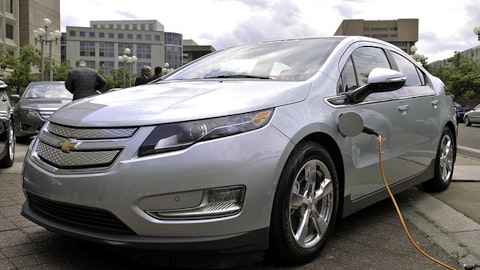Shreyas Patil: Okay. That’s very helpful. And then just if I guess just to clarify. We — if I adjust out the entire impact of the legacy DC charger, both the inventory charge and also the impact to margin ex that, it looks like gross margins would have been about 25% in the quarter. I just want to make sure I’m thinking about that right. And then when I think about the Q3 guide, which would be implying flat to maybe down margin sequentially, just how would I think about that bridge, excluding the impact of this legacy DC charger?
Rex Jackson: Yeah. So, Shreyas, I think your view of Q2 is accurate. Obviously, with the charge, it was 3%. Without the charge, it’s 22%. This is a 19-point hit. And then if you eliminated the headwind on the product because, obviously, we carry the old cost structure in the quarter, you’d be looking more like 25%, and that’s consistent with what we did in Q1. So, that’s — when we talk about the underlying health of the business, I think that’s where — that’s the explanation on that. As you look forward, we said — we gave you a range on gross margin. And frankly — and I — you’ve been with us for a while, we are a mix sensitive. I hate to admit that, but it’s true. We have historically had more AC than DC, and that’s at 50-50, and indeed maybe crossing over to DC, which is a lower margin product for us.
So, I wouldn’t have put a big range on — meaningful range on Q3. And we got to bank through the product availability, because we had a supply overrun, as we indicated in our prepared remarks. We need to bank through that until it makes it a little unpredictable because you’re going to do that onesies, twosies, or you’re going to cut a deal for 50 to 100, hard to say. So, I tried to leave that open. But as I said, I do think, as we look into next year and we clean through these issues in the next six months, we should have a clear line of sight to steadily improve the gross margin next year.
Shreyas Patil: Okay. Great. Thanks so much.
Rex Jackson: All right.
Operator: Thank you. We’ll go next now to Chris Pierce at Needham.
Chris Pierce: Hey. Good afternoon. You just talked about commercial customers, say, utilization was 20% and then that would leave the order a new charger. Like, where are we seeing it now? Like, where can you kind of frame it at? Are they waiting to get to 30%, or is it still TBD? And is there anything you can do to kind of incentivize them to move sooner rather than later?
Pasquale Romano: It depends on the segment. So, if you look at the utilization, your numbers are pretty consistent with utilization thresholds for passenger car, long haul trip, fast charge. And that’s just because humans are synchronized. So, the times of day that fast charge sites tend to see congestion are synchronized and then there are broad swaths of the day that they’re underutilized. So, your numbers generally correct for that segment. If you look at — I’ll take workplace, for example. Workplace measured over the hours of operation of the workplace itself for days in office. Now we have to adjust that post-COVID for the synchronized days in office. We are seeing utilization rates adjusted for the session gap in time between — if they’re using our waitlist feature, one car leaving and the next car arriving to take over that charging point, we’re seeing them approach effectively the theoretical max cap.
So, multiple of our largest workplace customers have come to us and said, can we think of a creative way of decompressing this because we effectively don’t have discretionary spend capability on things that are noncore to their business to their customers. And so, again, that’s an indicator that we’re kind of beyond the point of overutilization in a lot of commercial settings. And on mass, what they’re telling us is they’re waiting for budget relief to be able to adjust that. So, it really depends on the segment.
Chris Pierce: Okay. And just to clarify, are we talking about budget flush in the year-end or budget relief where you haven’t done that deep with them?
Pasquale Romano: Yeah. I mean I haven’t personally had the conversation in specific detail, but my sense from talking to our sales force broadly is that it is less of a budget flush and more of a restricted spend policy on discretionary items within many companies that are kind of sitting here in a hesitant macroeconomic environment, deciding how they want to basically put assurances around their balance sheet.
Chris Pierce: Okay. Could we just go one deeper then? Is it right to think of that as California-based large tech companies? Is that the right way to think about it? And that’s sort of an indicator of…
Pasquale Romano: No.
Chris Pierce: Okay.
Pasquale Romano: No. It’s — I mean that’s a component. I mean California being the state with the highest EV penetration is certainly going to be the poster child for impaction when it comes to most things associated with charging infrastructure, but other states have a similar profile. So, it’s — I don’t think it’s related to a particular geography. It has more to do with how penetrated EVs are into the geography.
Chris Pierce: Okay. And then just last question for me. Rex just kind of highlighted the gross margin guidance in Q3 was around mixed AC to DC. That sort of assumes that these customers are going to hold your planning for them to still be at hold in the next three months. Is it the right way to think about it over the next two months or beyond?




